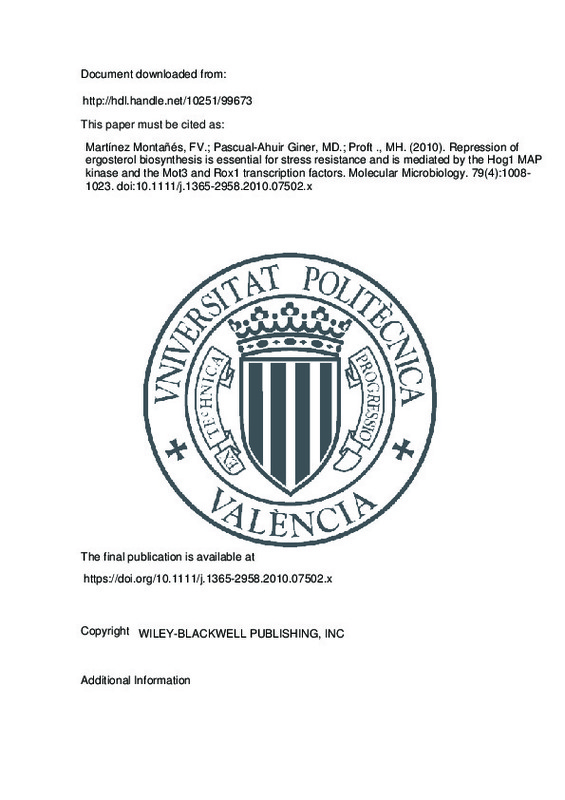Martínez Montañés, FV.; Pascual-Ahuir Giner, MD.; Proft ., MH. (2010). Repression of ergosterol biosynthesis is essential for stress resistance and is mediated by the Hog1 MAP kinase and the Mot3 and Rox1 transcription factors. Molecular Microbiology. 79(4):1008-1023. https://doi.org/10.1111/j.1365-2958.2010.07502.x
Por favor, use este identificador para citar o enlazar este ítem: http://hdl.handle.net/10251/99673
|
Título:
|
Repression of ergosterol biosynthesis is essential for stress resistance and is mediated by the Hog1 MAP kinase and the Mot3 and Rox1 transcription factors
|
|
Autor:
|
Martínez Montañés, Fernando Vicente
 Pascual-Ahuir Giner, María Desamparados
Proft ., Markus Hans
Pascual-Ahuir Giner, María Desamparados
Proft ., Markus Hans
|
|
Entidad UPV:
|
Universitat Politècnica de València. Instituto Universitario Mixto de Biología Molecular y Celular de Plantas - Institut Universitari Mixt de Biologia Molecular i Cel·lular de Plantes
Universitat Politècnica de València. Departamento de Biotecnología - Departament de Biotecnologia
|
|
Fecha difusión:
|
|
|
Resumen:
|
[EN] Hyperosmotic stress triggers a complex adaptive response that is dominantly regulated by the Hog1 MAP kinase in yeast. Here we characterize a novel physiological determinant of osmostress tolerance, which involves the ...[+]
[EN] Hyperosmotic stress triggers a complex adaptive response that is dominantly regulated by the Hog1 MAP kinase in yeast. Here we characterize a novel physiological determinant of osmostress tolerance, which involves the Hog1-dependent transcriptional downregulation of ergosterol biosynthesis genes (ERG). Yeast cells considerably lower their sterol content in response to high osmolarity. The transcriptional repressors Mot3 and Rox1 are essential for this response. Both factors together with Hog1 are required to rapidly and transiently shut down transcription of ERG2 and ERG11 upon osmoshock. Mot3 abundance and its binding to the ERG2 promoter is stimulated by osmostress in a Hog1-dependent manner. As an additional layer of control, the expression of the main transcriptional activator of ERG gene expression, Ecm22, is negatively regulated by Hog1 and Mot3/Rox1 upon salt shock. Oxidative stress also triggers repression of ERG2, 11 transcription and a profound decrease in total sterol levels. However, this response was only partially dependent on Mot3/Rox1 and Hog1. Finally, we show that the upc2-1 mutation confers stress insensitive hyperaccumulation of ergosterol, overexpression of ERG2, 11 and severe sensitivity to salt and oxidative stress. Our results indicate that transcriptional control of ergosterol biosynthesis is an important physiological target of stress signalling.
[-]
|
|
Palabras clave:
|
Activated protein-kinase
,
Leucine zipper protein
,
Saccharomyces-cerevisiae
,
Osmotic-stress
,
High-osmolarity
,
Budding yeast
,
Sterol homeostasis
,
Ion homeostasis
,
Gene-expression
,
Salt stress
|
|
Derechos de uso:
|
Reserva de todos los derechos
|
|
Fuente:
|
Molecular Microbiology. (issn:
0950-382X
)
|
|
DOI:
|
10.1111/j.1365-2958.2010.07502.x
|
|
Editorial:
|
WILEY-BLACKWELL PUBLISHING, INC
|
|
Versión del editor:
|
https://doi.org/10.1111/j.1365-2958.2010.07502.x
|
|
Código del Proyecto:
|
info:eu-repo/grantAgreement/MEC//BFU2005-01714/ES/ANALISIS GENÓMICO Y BIOQUÍMICO DE LOS BLANCOS DE LA MAP QUINASA HOG1 DURANTE LA ADAPTACION TRANSCRIPCIONAL A ESTRÉS OSMÓTICO/
info:eu-repo/grantAgreement/MICINN//BFU2008-00271/ES/RESPUESTA A ESTRES OSMOTICO EN SACCHAROMYCES Y ARABIDOPSIS: REGULACION DE LA CROMATINA Y DE LA ACTIVIDAD MITOCONDRIAL/
info:eu-repo/grantAgreement/CSIC//200820I019/
|
|
Agradecimientos:
|
We thank J.M. Mulet for his help with the quantification of intracellular ion concentrations, W.A. Prinz (NIH, Bethesda, MD) and A.K. Menon (Weill Cornell Medical College, New York) for the kind gift of the upc2-1 strain, ...[+]
We thank J.M. Mulet for his help with the quantification of intracellular ion concentrations, W.A. Prinz (NIH, Bethesda, MD) and A.K. Menon (Weill Cornell Medical College, New York) for the kind gift of the upc2-1 strain, F. Winston (Harvard Medical School, Boston) for the kind gift of the MOT3-18myc strain, and Avelino Corma (Instituto de Tecnologia Quimica, Valencia, Spain) for making available an ICP optical emission spectrometer for ion content determination. This work was supported by grants from Ministerio de Educacion y Ciencia (BFU2005-01714), from Ministerio de Ciencia e Innovacion (BFU2008-00271) and from Consejo Superior de Investigaciones Cientificas (200820I019). F.M. is recipient of an FPI predoctoral fellowship from Ministerio de Educacion y Ciencia.
[-]
|
|
Tipo:
|
Artículo
|







![[Cerrado]](/themes/UPV/images/candado.png)


